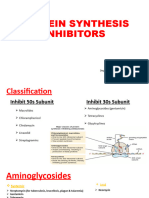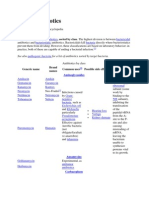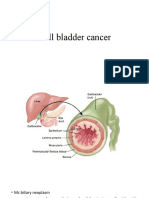Cell Wall Synthesis Inhibitors
Cell Wall Synthesis Inhibitors
Uploaded by
Farhana Azmira AsmadiCopyright:
Available Formats
Cell Wall Synthesis Inhibitors
Cell Wall Synthesis Inhibitors
Uploaded by
Farhana Azmira AsmadiOriginal Description:
Copyright
Available Formats
Share this document
Did you find this document useful?
Is this content inappropriate?
Copyright:
Available Formats
Cell Wall Synthesis Inhibitors
Cell Wall Synthesis Inhibitors
Uploaded by
Farhana Azmira AsmadiCopyright:
Available Formats
1.
BETA-LACTAMS Penicillin Type s Natural & Synthetic Binds to enzymes that cross-link peptidoglycansubunits An enzyme called transpeptidase(type of penicillin binding protein) forms the covalent bond between peptide side chains, with release of a terminal D-alanine-Penicillin binds and inhibits this enzyme As the cell wall continues to be formed, the lack of covalent bonds between the peptide side chains eventually results in cell lysis; breakage 2. 1. Cephalosporin
CELL WALL SYNTHESIS INHIBITORS OTHER Cycloserine Bacitracin
GLYCOPEPTIDASE Eg: Vancomycin
Blocking the transpeptidationreaction (forming the peptide crosslinks) By binding to the D-alanylD-alanineportion of the p entapeptidesidechain. This prevents formation of the covalent crosslinksbetween adjacent glycanchains. Similar to betalactamexcept beta lactamdrugs bind to the transpeptidaseenzyme itself Blocking the transgylcosylationreaction (elongating the glycanchains) large molecules that bind to cell wall precursors acts as a stericimpediment Result: Leads to structurally weakened cell wall until the cell lyses only active against G +veorganisms too large to cross G vecell wall
Mode of actions
Blocks synthesis of peptidoglycanprecursors by: inhibiting the conversion of L-alanineto D-alanine preventing the formation of the D-alanyl-Dalaninerequired for peptide side chain formation
Prevents regeneration of carrier molecule required for peptidoglycansynthesis by Inhibiting the enzyme pyrophosphatasethat removes the terminal phosphate from bactoprenolpyrophosphate (carrier molecule). Without removal of the terminal phosphate, bactoprenolcannot be used again to transport cell-wall precursors through the cell membrane
Only effective against growingbacteria no effect on stationary phase cells Not effective against species without cell walls (mycoplasma) with impenetrable cell walls (mycobacteria) That live as intracellular pathogens (Chlamydia) Beware penicillin allergy Least toxic of antibiotics From rash (25%) to anaphylactic shock (0.04% of cases)
Improved activity against Gram-verods Broad-spectrum For patients allergic to penicillin Although 10% of patients allergic to penicillin also allergic to cephalosporin Has it own side effects: thrombophlebitis, GIT disturbance
side effects: confusion, coma, liver damage Second-line drug for TB treatment
Topical use only (can cause kidney & liver damage) Effective against G +ve(Staphylococciand Streptococci)
Properties
Aminoglycosides bind to 30S ribosome and can Affect initiation Misreading of genetic code o Wrong amino acid inserted o Causes the membrane to damage and bact. Dies. not absorbed from gut, often IV infusion Ineffective against anaerobes as transport of drug into cell requires oxygen resistance due to altered cell permeability or 30S binding site Streptomycin bactericidal, used to treat tuberculousmeningitis Side Effects: hearing loss (irreversible) and renal damage if taken for prolonged periods Resistance Production of enzyme to prevent binding to ribosome Binding site on ribosome changes Neomycin used topically very toxic if used systematically Gentamicin active against many G ve
Tetracyclines Binds reversibly to 30S ribosomal subunit distort A site, prevent tRNAfrom binding i.e. prevent tRNAfrom entering acceptor site on the ribosome Broad spectrum, bacteriostatic(reversible binding) suppress normal gut flora GI disturbance o diarrhea and overgrowth of drug-resistant bacteria and fungi also bind to eukaryotic ribosomes(less efficiently) affect development of bones and teeth o Brown staining of teeth deposition of drug as tetis a calcium chelator not suitable for children, pregnant women Resistance usually alteration of cell membrane to exclude drug
PROTEIN SYNTHESIS INHIBITOR Chloramphenicol
Microlides (Erythromycin)
Lincosamides
Mode of Action
binds to 50S subunit, inhibits peptide bond formation blocks elongation
binds to 50S ribosome, blocks the translocation step by preventing the release of the uncharged (or empty) tRNAfrom the donor site after the peptide bond is formed
Properties
Commonly bacteriostatic, bacteriocidalto S. pneumoniae, H. influenzaeand N. meningitides broad spectrum, can kill even anaerobic bacteria However can cause GI disturbance, overgrowth of C. albicans can occur small, polar; so oral administration possible crosses blood-brain barrier used to treat bacterial meningitis toxicity and resistance limit usefulness of drug Potential side-effects: Bone marrow toxicity (but reversible) and aplastic anemia toxic to neonates (immature liver) Grey baby syndrome
bacteriostatic, most active against G+vecells alternative to penicillin, especially for Strep infection side effects are mild, may cause nausea Resistance: due to altered ribosomaltarget site
active against anaerobes; penetrates bone useful for osteomyelitis Serious side effect potentially fatal pseudomembranousc olitis Caused by overgrowth of Clostridium difficilewhich produces necrotizing toxins C. difficileovergrows because it is always resistant to clindamycin
resistance common primarily due to enzymatic modification that prevents drug binding to ribosome
Antibiotic Aminoglycoside s
Ribosomal Subunit 30S
Mode of Action Blocks functioning of initiation complex and causes misreading of mRNA
Bactericidal or Bacteriostatic Bactericidal
Side Effects
Resistance due to altered cell permeability or 30S binding site
Tetracyclines
30S
Blocks tRNAbinding to ribosome
Bacteriostatic
Chloramphenic ol
50S
Blocks peptidyltransferase
Both
Erythromycin
50S
Blocks translocation
Primarily Bacteriostatic Primarily bacteriostatic
diarrhea and overgrowth of drugresistant bacteria and fungi affect development of alteration of cell membrane to bones and teeth o Brown staining exclude drug of teeth deposition of drug as tetis a calcium chelator enzymatic Bone marrow toxicity (but modification that reversible) and prevents drug aplasticanemia binding to ribosome due to altered Nausea ribosomaltarget site potentially fatal pseudomembranouscolitis
Clindamycin
50S
Blocks translocation
3. NUCLEIC ACID SYNTHESIS INHIBITORS DNA synthesis (replication) inhibitors Quinolones
Properties synthetic chemotherapeutic agents inactivate bacterial gyrase(= DNA topoisomeraseII) and topoisomerase enzymes that wind and unwind DNA dont bind to mammalian enzymes, minimal toxicity Resistance: due to alterations in DNA gyraseor cell membrane permeability for G-veenteric bacteria; sometimes used for UTI
Naladixic Acid
Fluoroquinolones have broader spectrum of activity (G +ve, G -ve, anaerobes)
RNA synthesis (transcription) inhibitors
Properties Rifampicin(Rifampin) o inactivates RNA polymerase, blocks mRNA synthesis - broad spectrum (GI disturbance) - effective against Mycobacterium tuberculosis - occasional side effects: liver damage, allergic reactions Resistance increasing o due to mutation of binding site on RNA polymerase Rifampicinis usually given in combination with other drugs because resistant mutants appear at a high rate when used alone
Rifamycins
Nucleotide synthesis inhibitors
Properties analogues of para-aminobenzoicacid (PABA), a precursor of tetrahydrofolicacid (THFA) o required for nucleotide synthesis in bacteria (mammals obtain THFA in diet) o competitive inhibitor, so bacteriostatic o active against G ve, so good for UTIs but resistance widespread
Sulfonamides
Trimethoprim Co-trimoxazole
acts at a later point in nucleotide synthesis pathway = Trimethoprim + sulfamethoxazole (sulfonamide) synergistic drug interaction; resistance less likely useful for long term prophylaxis of UTIs
4. BACTERIAL MEMBRANE DISRUPTORS depolarisebacterial membranes affect membrane transport processes, ATP synthesis Daptyomycinis useful against MRSA, VRE bactericidal, detergent-like action active against most G-veorganisms toxic to kidney and neural tissues topical use for G veinfections
Lipopeptides
Polymyxin B
You might also like
- Adult Infectious Disease Bulletpoints HandbookFrom EverandAdult Infectious Disease Bulletpoints HandbookRating: 4.5 out of 5 stars4.5/5 (9)
- Antibiotics Summary - Flattened PDFDocument3 pagesAntibiotics Summary - Flattened PDFmicheal1960100% (7)
- AntibioticDocument84 pagesAntibioticDr. Kalavati PrajapatiNo ratings yet
- Pharmacology - Chapter 29Document5 pagesPharmacology - Chapter 29Ashley-Michelle LewisNo ratings yet
- Exam Saq Revision QuestionsDocument5 pagesExam Saq Revision QuestionsFarhana Azmira AsmadiNo ratings yet
- Exam Saq Revision QuestionsDocument5 pagesExam Saq Revision QuestionsFarhana Azmira AsmadiNo ratings yet
- Change Your Brain, Change Your Life (Revised and Expanded) The Breakthrough Program For Conquering Anxiety, Depression, Obsessiveness, Lack of Focus, Anger, and Memory Problems PDF DownloadDocument2 pagesChange Your Brain, Change Your Life (Revised and Expanded) The Breakthrough Program For Conquering Anxiety, Depression, Obsessiveness, Lack of Focus, Anger, and Memory Problems PDF Downloadwang lembak0% (13)
- Fdar - DMC FinalDocument72 pagesFdar - DMC FinalKewkew Azilear100% (4)
- Antibiotics - Method of Action PDFDocument51 pagesAntibiotics - Method of Action PDFmortezahNo ratings yet
- 22 - Disease Biology PDFDocument28 pages22 - Disease Biology PDFashutosh samalNo ratings yet
- Lecture 5 - Antibiotics PDFDocument85 pagesLecture 5 - Antibiotics PDFNenad Đorđević100% (2)
- Protein Syntheis InhibitersDocument43 pagesProtein Syntheis InhibitersMona AdamNo ratings yet
- Antibiotics IntroductiontoClassificationDocument16 pagesAntibiotics IntroductiontoClassificationFarida CitraNo ratings yet
- Cell Wall Synthesis Inhibitors & Protein SynDocument25 pagesCell Wall Synthesis Inhibitors & Protein SynABID OFFICIAL CHANNELNo ratings yet
- ANTIBIOTICS StudentDocument34 pagesANTIBIOTICS Studentcaitie miracleNo ratings yet
- AntibioticsDocument16 pagesAntibioticsrajasri8jallaNo ratings yet
- Chemotherapy & Antibiotics: - Kalpesh ZunjarraoDocument37 pagesChemotherapy & Antibiotics: - Kalpesh ZunjarraopriyankaNo ratings yet
- Newer Antibiotics: Guide: DR Saroja A ODocument51 pagesNewer Antibiotics: Guide: DR Saroja A OparahulNo ratings yet
- The Kidney!) : Penicillin V Penicillin GDocument10 pagesThe Kidney!) : Penicillin V Penicillin GUsm LeeNo ratings yet
- Pseudomonas Aeruginosa. Effective: Antibiotics by ClassDocument4 pagesPseudomonas Aeruginosa. Effective: Antibiotics by ClassDocFrankNo ratings yet
- Antimicrobial DrugsDocument44 pagesAntimicrobial Drugsreza tavayef100% (1)
- Antimicrobial ChemotherapyDocument70 pagesAntimicrobial Chemotherapyamanialwerfalli4No ratings yet
- Chemotherapeutic DrugsDocument122 pagesChemotherapeutic Drugsdex7reme100% (1)
- Antimicrobials: Mode of Action Mechanism of Resistance Origin of Resistance Spectrum of Activity Classic Side EffectsDocument43 pagesAntimicrobials: Mode of Action Mechanism of Resistance Origin of Resistance Spectrum of Activity Classic Side Effectssupermanofearth27No ratings yet
- AntibioticsDocument11 pagesAntibioticsSeshu Kelam100% (3)
- Inhibitor of Cell Wall Synthesis (ICWS) : Proteus ComboDocument12 pagesInhibitor of Cell Wall Synthesis (ICWS) : Proteus Comboflomax23100% (2)
- Microbiology Assignmentt xxx123Document16 pagesMicrobiology Assignmentt xxx123ADITYAROOP PATHAKNo ratings yet
- Antimicrobial AgentsDocument29 pagesAntimicrobial Agentsyaya mohaNo ratings yet
- Antibiotics PharmacologyDocument27 pagesAntibiotics PharmacologyKevil LoriyaNo ratings yet
- Antimicrobialchemotheray PDFDocument80 pagesAntimicrobialchemotheray PDFغمدان دماج الحمزيNo ratings yet
- List of AntibioticsDocument10 pagesList of AntibioticsAia JavierNo ratings yet
- Protein Synthesis InhibitorsDocument25 pagesProtein Synthesis InhibitorsSawsan Z. JwaiedNo ratings yet
- Antibiotics Resistance - 20WDocument24 pagesAntibiotics Resistance - 20WflubbybananaNo ratings yet
- AntibioticsDocument10 pagesAntibioticsStevhenson PortacioNo ratings yet
- Antibiotics and Their Mechanism of ActionDocument8 pagesAntibiotics and Their Mechanism of Actionkalaiyarasanmm2503No ratings yet
- Pharmacology-Antibiotic 2021Document52 pagesPharmacology-Antibiotic 2021Ngọc VânNo ratings yet
- Antimicrobial DrugsDocument83 pagesAntimicrobial DrugsmokhtarNo ratings yet
- Protein Synthesis InhibitorsDocument59 pagesProtein Synthesis InhibitorsApurba Sarker Apu100% (1)
- Mechanisms of Antibiotic Action, Class PPT IIDocument13 pagesMechanisms of Antibiotic Action, Class PPT IILarry TongNo ratings yet
- Antibiotics F MCP 1Document37 pagesAntibiotics F MCP 1Mohamed ElraiyNo ratings yet
- Antibiotics: by Dr. Jihad AnadDocument89 pagesAntibiotics: by Dr. Jihad AnadJihad AnadNo ratings yet
- Chemotherapy Lect 1Document26 pagesChemotherapy Lect 1kazelio2017No ratings yet
- Protein Synthesis InhibitorsDocument28 pagesProtein Synthesis InhibitorsMaha JabeenNo ratings yet
- Common Antibiotics Master List: Rodney Paullus Dewight Cowley Izzy Winestone Ben BowmanDocument20 pagesCommon Antibiotics Master List: Rodney Paullus Dewight Cowley Izzy Winestone Ben BowmanMahendra VermaNo ratings yet
- Antibiotics by ClassDocument9 pagesAntibiotics by ClassHerlin Ajeng NurrahmaNo ratings yet
- Generic Name Brand Names Common Uses Possible Side Effects Mechanism of ActionDocument13 pagesGeneric Name Brand Names Common Uses Possible Side Effects Mechanism of Actionangel3424No ratings yet
- List of Antibiotics: Following Is The List Of, Sorted by Class. The Highest Division Is BetweenDocument11 pagesList of Antibiotics: Following Is The List Of, Sorted by Class. The Highest Division Is BetweenBhanuprakash PuthalapattuNo ratings yet
- Pharmacotherapy of ENT InfectionsDocument86 pagesPharmacotherapy of ENT InfectionsHoque Mohammed Newaz ShorifulNo ratings yet
- Resistensi Mikroba Terhadap AntibiotikaDocument32 pagesResistensi Mikroba Terhadap AntibiotikameandyoooouNo ratings yet
- Laboratory of Microbiology Medical Faculty UB 2009Document37 pagesLaboratory of Microbiology Medical Faculty UB 2009zianaNo ratings yet
- ChemotherapyDocument66 pagesChemotherapyElias HaimanotNo ratings yet
- AntibioticsDocument40 pagesAntibioticsSonu SinghNo ratings yet
- 2008 Block2 ReviewDocument28 pages2008 Block2 ReviewbellNo ratings yet
- Pharmacology III Drug Profile Spots Falll 2020Document30 pagesPharmacology III Drug Profile Spots Falll 2020eternalmadloveNo ratings yet
- Anti Microbial NotesDocument10 pagesAnti Microbial NotesMohammed Faisal UddinNo ratings yet
- Antibiotic Resistance PDFDocument6 pagesAntibiotic Resistance PDFGea MarieNo ratings yet
- Micro 5Document37 pagesMicro 5Ha LeemNo ratings yet
- Antimicrobial DrugsDocument63 pagesAntimicrobial DrugsMarianaBologan100% (1)
- Pharmacology: Fast and Dirty Board ReviewDocument7 pagesPharmacology: Fast and Dirty Board ReviewRochelleth7278No ratings yet
- Anti-Tuberculosis DrugsDocument12 pagesAnti-Tuberculosis DrugsAkashNo ratings yet
- Antimicrobial AgentsDocument3 pagesAntimicrobial AgentsErnie G. Bautista II, RN, MD100% (2)
- Antibacterial Drugs: B.K. SatriyasaDocument56 pagesAntibacterial Drugs: B.K. SatriyasaVicNo ratings yet
- Molecular and Cellular Biology of Pathogenic TrypanosomatidsFrom EverandMolecular and Cellular Biology of Pathogenic TrypanosomatidsNo ratings yet
- Recent Progress in Pharmaceutical Nanobiotechnology: A Medical PerspectiveFrom EverandRecent Progress in Pharmaceutical Nanobiotechnology: A Medical PerspectiveNo ratings yet
- S2 2006 Q1 2 9Document2 pagesS2 2006 Q1 2 9Farhana Azmira AsmadiNo ratings yet
- Tut2 Exam QuestionsDocument2 pagesTut2 Exam QuestionsFarhana Azmira AsmadiNo ratings yet
- Treatment and Prevention of Pulmonary TuberculosisDocument42 pagesTreatment and Prevention of Pulmonary TuberculosisFarhana Azmira AsmadiNo ratings yet
- Tutorial 4 - Haematopoeisis & Blood Clotting CascadeDocument5 pagesTutorial 4 - Haematopoeisis & Blood Clotting CascadeFarhana Azmira AsmadiNo ratings yet
- Hypersensitivity ReactionsDocument6 pagesHypersensitivity ReactionsFarhana Azmira AsmadiNo ratings yet
- Tutorial 6 - Apoptosis & HIVDocument6 pagesTutorial 6 - Apoptosis & HIVFarhana Azmira AsmadiNo ratings yet
- Tutorial 2 - Cell CycleDocument3 pagesTutorial 2 - Cell CycleFarhana Azmira AsmadiNo ratings yet
- Salmonellasis Typhoid Fever Campylobacter Jejuni Yersinosis ShigellosisDocument5 pagesSalmonellasis Typhoid Fever Campylobacter Jejuni Yersinosis ShigellosisFarhana Azmira AsmadiNo ratings yet
- Proposition 1B Project Close-Out ProcessDocument4 pagesProposition 1B Project Close-Out ProcessFarhana Azmira AsmadiNo ratings yet
- Disease (Virus) Genome Virus Properties Transmission Outcome Diagnosis PreventionDocument2 pagesDisease (Virus) Genome Virus Properties Transmission Outcome Diagnosis PreventionFarhana Azmira AsmadiNo ratings yet
- Revision MBB DR Hue FullDocument14 pagesRevision MBB DR Hue FullFarhana Azmira Asmadi0% (1)
- BiologyDocument41 pagesBiologyOmar MohamedNo ratings yet
- Antimalarials - Are They Effective and Safe in Rheumatic DiseasesDocument10 pagesAntimalarials - Are They Effective and Safe in Rheumatic DiseasesYahya RizkiNo ratings yet
- The Philippine Aids Prevention and Control Act of 1998Document84 pagesThe Philippine Aids Prevention and Control Act of 1998Jared Joshua DalidaNo ratings yet
- Exp. 9 Test For Vitamin CDocument5 pagesExp. 9 Test For Vitamin CEdchelNo ratings yet
- Beat Forest OfficerDocument7 pagesBeat Forest Officerകൂട്ടുകാരിയെ സ്നേഹിച്ച കൂട്ടുകാരൻNo ratings yet
- Losartan Drug StudyDocument2 pagesLosartan Drug StudyCheezy Bread100% (1)
- A New Professional Imperative: One HealthDocument76 pagesA New Professional Imperative: One HealthRidho GNo ratings yet
- Characteristics: AppearanceDocument2 pagesCharacteristics: AppearanceDimpleMakwanaNo ratings yet
- 2014lorazepam InduceddiplopiaDocument3 pages2014lorazepam InduceddiplopiaVikas PsNo ratings yet
- Gift Research PropoalDocument19 pagesGift Research PropoalEvangelist Kabaso Sydney100% (1)
- 2023 - George Felfoldi (eBook-Health) It's All About The Broccoli, 147 PagesDocument147 pages2023 - George Felfoldi (eBook-Health) It's All About The Broccoli, 147 PagesGeorge Felfoldi100% (2)
- Epididymoorchitis PDFDocument6 pagesEpididymoorchitis PDFdidiNo ratings yet
- Treatment Considerations For The Patient With Borderline Personality DisorderDocument9 pagesTreatment Considerations For The Patient With Borderline Personality DisorderMoonyNo ratings yet
- Gall Bladder CancerDocument29 pagesGall Bladder CancerJoju SebastianNo ratings yet
- Noise and Vibration HazardsDocument28 pagesNoise and Vibration HazardsAKANKSHANo ratings yet
- Final ScribdDocument23 pagesFinal ScribdmarjorycimburankNo ratings yet
- Theory 1poultry IndustryDocument15 pagesTheory 1poultry IndustryRamesh BeniwalNo ratings yet
- Compare and Contrast Process in Plants and Animals: Immune SystemsDocument28 pagesCompare and Contrast Process in Plants and Animals: Immune SystemsdljbNo ratings yet
- Answers To Exam Practice: Chapter 3 Cellular OrganizationDocument6 pagesAnswers To Exam Practice: Chapter 3 Cellular Organizationan ChiNo ratings yet
- Family Micrococcaceae PDFDocument73 pagesFamily Micrococcaceae PDFJean Tsuna KalawNo ratings yet
- Resume LeafletDocument10 pagesResume LeafletYAALINY YKNo ratings yet
- PIIS2405844023090187Document12 pagesPIIS2405844023090187Katalin BodorNo ratings yet
- Animal TestingDocument4 pagesAnimal TestingCatherine McNallyNo ratings yet
- DLL - Mapeh 6 - Q1 - W2Document5 pagesDLL - Mapeh 6 - Q1 - W2Jezryl Magramo FaloNo ratings yet
- Vertical DimensionDocument28 pagesVertical DimensionHarini PadmanabhanNo ratings yet
- 2010 05 11 Gluten Free DemandDocument3 pages2010 05 11 Gluten Free DemandShannon SadlerNo ratings yet
- Strategies in Reconstruction of The Atrophic MaxillaDocument19 pagesStrategies in Reconstruction of The Atrophic MaxillaEmil CorreaNo ratings yet




































































































